Release Notes
Abstract
This document lists the new features and enhancements included in the 7.6 release. Releases of IBM® Rational® Rhapsody® are cumulative, meaning that they include all new features or enhancements from earlier releases.
Content
The IBM® Rational® Rhapsody® Version 7.6 introduces new capabilities to facilitate team collaboration, sharing, and review of designs across the organization and development team. Additionally, improved simulation, analysis, testing, and performance capabilities help systems engineers and embedded software developers deliver high-quality applications. Although there are more additions and enhancements, these are among the highlights of new features introduced in this release:
· Web access for team collaboration, searching. and review through IBM® Rational® Jazz™ technology integration with Rational Rhapsody Design Manager 3.0
· Improved simulation, analysis, and validation capabilities for validation of functionality and integration of design with plant models of the physical world
· Capabilities to help meet safety-critical development standards, such as ISO 26262, IEC 61508, and IEC 62304
· More robust systems and software testing capabilities
· Updated UI and usability improvements
These new features, plus other enhancements, help systems engineers and developers of real-time or embedded software increase productivity and deliver innovative products. The sections that follow provide more details.
Collaborative design management built on Jazz technology
Rational Rhapsody models can now be automatically published to a Jazz-based central location and accessed using Rational Rhapsody Design Manager. This enables the extended team to obtain key design information by using a web client. Rational Rhapsody Design Manager 3.0 provides numerous new features and advantages that are described in the subsections that follow. To view a demo of Rational Rhapsody Design Manager see the Resources section at the end of this document.
Design management server built on the Jazz platform
Teams can store and manage different types of architecture, designs, and models in a central location that is easily accessible by design teams and extended stakeholders.
You can automate publishing of Rational Rhapsody models to the server to share the latest model information to help ensure that team members are working with the latest version of the design. Snapshots also enable team members to refer to previous versions of the design.
Designs can be imported from the file system or an SCM (software configuration management) system and organized into projects. Initial support is provided for importing and managing designs created by either Rational Rhapsody or IBM® Rational® Software Architect tools.
Enterprise and system-wide searching
Teams can search across multiple Rational Rhapsody projects stored in the server project, which assists in locating information faster.
Web client
Stakeholders can access information through a web client to search, navigate, access, and review designs. This improves the ability of stakeholders to participate in the design process without being required to install a Rational Rhapsody client.
Collaborating on designs
Product and program managers, systems engineers, and software engineers can collaborate on designs with stakeholders from other teams for design correctness, alignment with requirements, feasibility, and compliance with organizational standards. The design review process can be automated by allowing stakeholders to provide comments and markups on designs directly on the server. The comments and markups are saved with the designs on the Rational Jazz server and can be accessed with the Rational Rhapsody client.
Systems engineering and lifecycle integrations
Teams can link designs and design elements to other designs and lifecycle data through Open Services for Lifecycle Collaboration (OSLC), which gives them design traceability and impact analysis. For example, a class can be linked with a work item in IBM® Rational Team Concert™ (see Figure 1) so that other team members can easily find the design element related to their work.
Figure 1. Links can be created through OSLC
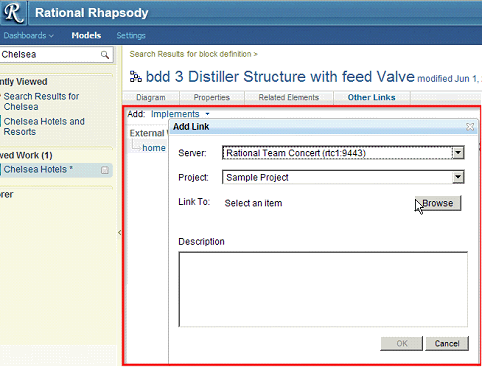
Dependency analysis
A relationship diagram (see Figure 2) is provided so that users can select a design element and visually explore its relationships to other designs, design elements, and lifecycle data. It can also show relationships to work items, other model elements, or even external websites.
Figure 2. Relationship diagrams show related elements
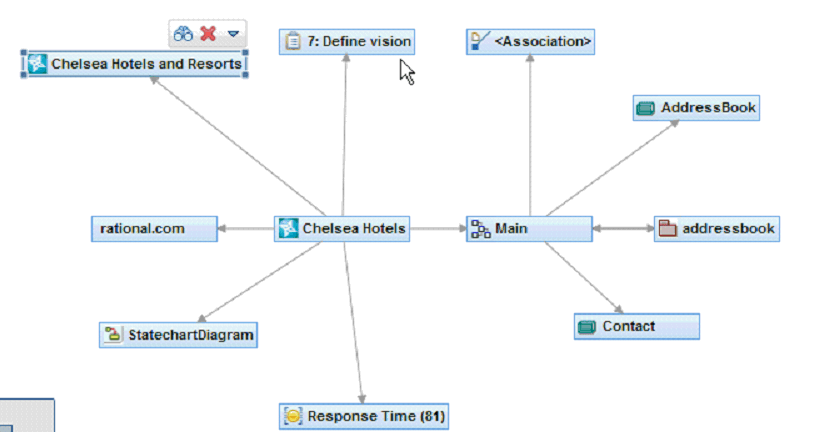
Dashboards
Dashboards provide team members with a live view to follow design management and other lifecycle activities through a web dashboard. The Design Management dashboards can include dashboard viewlets from other Jazz-based software so that the dashboard provides a consolidated view of the overall development lifecycle.
Document generation and reporting
Information that is stored in the Jazz project can be extracted to create comprehensive documentation for specifications, communication, compliance, and auditing when used in conjunction with the IBM® Rational® Publishing Engine. Documents can include designs, information about design reviews, and comments. They can also show the impact of design changes on other lifecycle resources by using the OSLC links.
Design Manager and Design Reviewer roles
IBM Rational Rhapsody Design Manager offers two role-based licenses: Design Manager and Design Reviewer.
· The Design Manager role is for team members who are using Rational Rhapsody to create and modify designs and need to update those designs on the Design Management server, create snapshots, and conduct design reviews.
· The Design Reviewer role is for stakeholders who need to collaborate, search, view, and review designs but do not create or modify the designs directly.
Enhanced systems engineering
Rational Rhapsody v7.6 improves support for model-based systems engineering with improvements for early analysis and validation of design, enhances support for SysML to capture complex systems, plus adds many usability functions to help automate daily tasks of the systems engineer.
Improved activity diagram simulation
IBM Rational Rhapsody v7.6 offers enhanced abilities to simulate activity diagrams by using token passing semantics. The enhancements include support for object nodes, object flows through control nodes, and time events. Additionally, you can use activity diagrams to specify the behavior of use cases and operations, thereby providing the ability to visually debug use case and operations behaviors to uncover potential design errors.
In addition, the model execution control is improved to assist in debugging activity diagrams. The new "Go Action" animation command continues execution until the next action is entered to enable better control over the animation. Also, it is now possible to set a break point on an action to be able to examine the current state of the system when an action of interest is entered.
Animation can now be configured so that animated activity diagrams automatically open when an occurrence is detected in that diagram. This is controlled by the Animation::General::AutoOpenBehavioralDiagrams property.
Note:Activity diagram simulation is available with IBM Rational Rhapsody Designer for Systems Engineers and IBM Rational Rhapsody Developer for C++.
Figure 3. Actions and flows highlight activity diagrams during simulation for early validation

Generation of control-plant models as Simulink models
It is now possible to generate The MathWorks Simulink model from a Rhapsody structured block or class that consists of connected parts typed by Simulink and Rhapsody blocks. This can allow simulation of hybrid plant-control systems consisting of continuous and discrete components. It also allows performing co-simulation with Simulink that includes the entire Rhapsody model. Within Rational Rhapsody, the architecture and plant models can be captured together with the plant models represented as Simulink blocks. The entire design can be exported to the Simulink simulator. The simulation is started in Simulink, and the IBM Rational Rhapsody blocks are then animated in Rhapsody to provide co-simulation of the design, interacting with the physical world modeled as a plant model to help validate the design behavior early in the development lifecycle.
Functional decomposition improvements
Rational Rhapsody 7.6 provides improvements to support refinement of system behavior through functional decomposition (see Figure 4). With the addition of execution of operation and activities for use cases, it is possible to validate the behavior and address any issues early to avoid costly problems later in the development lifecycle. The ability to change actions to call operation actions or call behavior actions enables refinement of actions. Parameters are synchronized for operation arguments, activity parameters, and event parameters with action pins to help maintain design consistency during changes.
Figure 4. Improved synchronization helps maintain consistency for functional decomposition
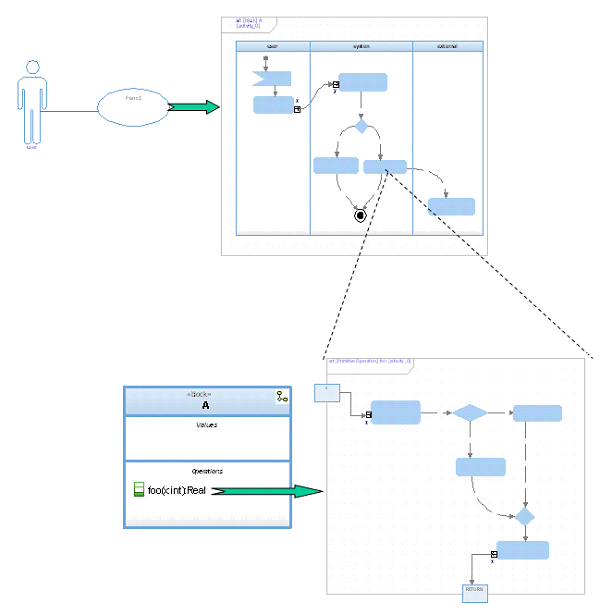
Viewpoints for visual filtering
SysML viewpoints allow for the display of different views of the model, which helps tailor the view of the model around a particular perspective, for example Mechanical or Safety. It is possible to apply a viewpoint to the Rational Rhapsody browser or diagrams and to filter the model based on that perspective, thereby enabling you to focus on a particular view of the design. In the design, you create conform relations from a model element to the viewpoint that includes it. The Rational Rhapsody query mechanism provides a way to filter the browser and diagrams (see Figure 5). A query can be specified to conform to the viewpoint, thus allowing for the browser and diagrams to be filtered based on the viewpoint.
Figure 5. Viewpoint can be specified in a query and then used to filter the browser and diagrams
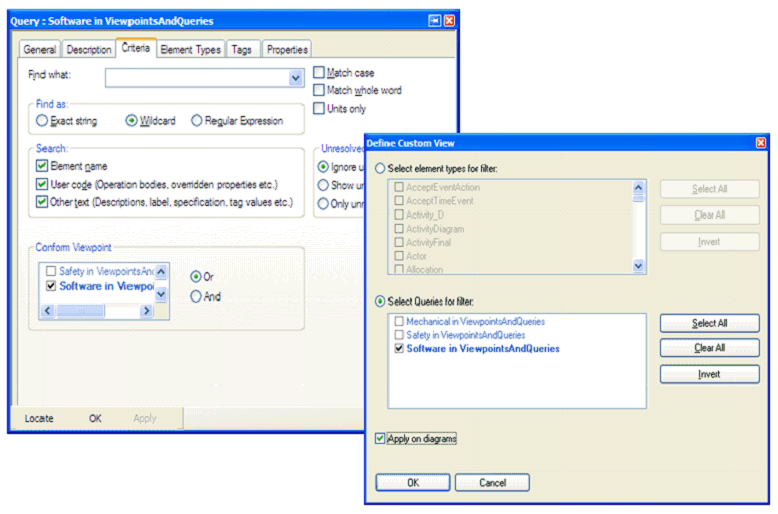
Improvements for Rational Harmony
New capabilities are added to the Systems Engineering (SE) Toolkit to support automation of more modeling constructs and to help improve usability, particularly when used in the context of the IBM® Rational® Harmony for Systems Engineering workflow. Often, a system might initiate a function on its own that might trigger an action by an actor. Support is added for inverse actor pins for the sequence when the system is triggering the actor, for example when sending a message after running a diagnostic test. It is also now possible to launch the model toolbox from the right-click drop-down menu to make it easier to access key functions. Additionally, support for the send, accept, and time event actions is added when generating sequence diagrams to help automate the system engineering process.
Comparing alternatives for trade studies
This version introduces the support of UML and SysML instance specifications so they can be used to represent different design alternatives for doing trade studies by using the Parametric Constraint Evaluator (PCE) feature. You can model different instances of SysML blocks that differ in their attribute values, the multiplicity of their parts, and even what kinds of parts are being used. Each instance represents a design alternative that can be compared by using parametric diagrams and constraint views. For example, you might want to alter an attribute to change the size or weight of a part; to trade off changing a part of a block, such as comparing a diesel to gasoline engine; or to change the composition by quantity, such as changing from 4- to 6-cylinder engines. It is also possible to automatically fill in default values, such as specification, based on the part hierarchy rather than having to specify instances for each of the parts and wiring them together.
Support for safety-critical software development
Software engineers who are developing products with safety-critical concerns need to adhere to standards such as ISO 26262, DO-178B, IEC 61508, or IEC 62304. This might require following strict coding and testing guidelines to comply with these standards. Rational Rhapsody Developer v7.6 (see the Resources section at the end of this document) helps teams adhere to safety-critical standards by providing a simplified execution framework that is optimized to include only key functionality. This helps abstract the design of complex systems while also meeting safety concerns. Also, an adapter for ARINC 653 using APEX API is included, as are improved MISRA coding guidelines that facilitate certification to safety standards.
Simplified C++ Execution Framework
The new, simplified execution framework for Rational Rhapsody Developer for C++ assists in documenting, verifying, and validating an application to meet safety-critical standards. The simplified framework is compact and delivers key capabilities for developing robust applications while also focusing on the needs of certification. The simplified framework provides active classes for multithreaded applications and a static architecture with a static memory manager for event allocation to avoid dynamically allocation of events. New project settings for C++ for safety-critical standards are applied with the SafetyCriticalC++ project settings.
Table 1. Comparison of Simplified (SXF) to Standard C++ Execution Framework (OXF)
| SXF C++ | OXF C++ |
| Static architecture | Dynamic allocation |
| MISRA C++ 2008 compliance with modeling checks | Not validated for MISRA |
| No animation, tracing | Animation, tracing |
| Only Real Time mode | Real Time, Simulated Time modes |
| No containers (can be added) | Containers |
| Static memory manager (only BasedNumberOfInstances) | Static memory manager |
| Flat state charts | Flat, reusable state charts |
| No multicore | Multicore |
| No interfaces | Interface-based |
| No ports | Ports |
| Windriver Workbench 653 Adapter or Microsoft Visual Studio 2008 or 2010 (for host) support | Multiple operating systems support |
ARINC 653 and VxWorks653 adapter
ARINC 653 is a specification for an application executive used for integrating and partitioning avionics systems on modern aircraft to help in the development of Integrated Modular Avionics (IMA) systems. It enables decoupling the real-time operating system from the application by providing an API called Application Executive (APEX) for functions such as time and space (memory) partitioning, health monitoring (error detection and reporting), and communication through “ports.” ARINC 653-compliant operating systems and applications are typically certified according to FAA DO-178B, and support is provided to isolate applications to different partitions to keep operation of applications with different safety levels from adversely affecting one another.
Rational Rhapsody v7.6 provides an ARINC 653 adapter that is supported with the Simplified C++ Execution Framework to develop and design applications that target ARINC 653. It uses the APEX API for VxWorks 653 application executive, while also leveraging the Rhapsody ability to trace to requirements that might be provided with IBM® Rational® DOORS® to help automate safety certification. Additionally, Rational Rhapsody Developer for C++ also provides a WorkbenchManaged653 environment for its standard object execution framework (OXF) that uses Wind River VxWorks653 POSIX-based adapter, which enables applications to be developed using this environment.
MISRA C++ code development
Following coding standards can provide confidence in the safety of a software application. The MISRA C++ standard was developed in the automotive industry, but is also accepted in other industries as a recommended set of guidelines for coding. When using the MISRA C++ settings, the Rational Rhapsody code generator is enhanced for better support of generation of code that complies with MISRA C++, with improvements such as improved const generation for accessors and mutators, setting default attributes and relationship visibility to private, state chart generation improvements, and calls to virtual constructors within a constructor or destructor. Additionally, warnings are issued by check model when using modeling constructs that might lead to MISRA violations, such as animation, tracing, inherited state charts, reusable state charts, initialized classes that are not embeddable, simulated time, the Rational Rhapsody Webify feature, and ports.
C development for safety-critical applications
For the development of safety-critical applications using the C language, the MicroC eXecution Framework (MXF) file structure is refactored to separate the core capabilities from utilities to assist in certification. The core capabilities are defined as RiCEvent, RiCReactive, RiCTaskEM, RiCTimer, RiCtypes, RiCEventQueue, RiCOXF. Improvements also simplify the implementation of the RiCReactive and RiCTimer code and remove dependencies on generic utilities such as RiCHeap and improve MISRA C compliance.
Requirements generated into state chart code
Traceability from requirements to the code is very important aspect of ensuring that the application is meeting all requirements and that all the code included in the application is traced to a requirement. The Rational Rhapsody capability to generate requirement and description information automatically into the generated code is extended by making it possible to generate this information into the code of states and transitions linked to a requirement.
Figure 6. Requirement information traced to a state or transition is generated into the code

Testing improvements for safety and quality
Testing is a key aspect to verify and validate the safety of design when failure could cause injury or even death. A great deal of project time is spent in validation and testing. The Rational Rhapsody TestConductor Add On provides visualization and automation for testing to help reduce the time spent testing across the development lifecycle, from systems specification through to system validation testing.
Code coverage of test cases
On a safety-critical system, every line of code needs to be validated to ensure there are no potential risks for a catastrophic failure. The TestConductor Add On now calculates code coverage of the test cases executed by the add-on when applied to C code. The results can be used to support the certification of an application for safety-critical standards.
Statement, Condition/Decision (CD), Modified Condition/Decision (MCDC) coverage is provided in the coverage analysis, and references to the results are stored in the Rational Rhapsody model.
Figure 7. Enable computation of code coverage before running tests to produce coverage results

Specifying complex test scenarios
As complexity of functionality of products increases, so can the test cases needed to validate their behavior. Test cases can require loops or consider alternative test paths, based on a condition to validate functionality. In addition, performance requirements might also need to be validated. IBM Rational Rhapsody TestConductor Add On for v7.6 provides the ability to use interaction operators (such as opt, alt, loop, break, parallel, and consider) on sequence diagrams to specify test cases, allowing complex test flows to be developed. Timing constructs can also be added to scenarios to assist in validating performance requirements of the design. It is also possible to store test input data in a separate file and use it to input values into sequence diagram test cases to help make it easier to maintain test cases by controlling input conditions.
Figure 8. Sequence diagram test cases can be specified with interaction operators

Testing on embedded targets
The Rational Rhapsody TestConductor Add On generates test code that is included in the generated executable, which allows tests to be run independently, with the results subsequently evaluated. This allows tests to be run on almost any embedded target.
Android application testing
The TestConductor Add On v7.6 adds support for testing Android applications, thus allowing Android developers to leverage the benefits of visual test development using sequence diagrams, flow charts, or state charts to help automate testing tasks and improve quality of their Android applications.
Figure 9. Perform unit testing of Android applications to improve quality and validate behavior

Usability and performance improvements
When you open a project with IBM Rational Rhapsody v7.6, you will notice a new look and feel for the diagrams and toolbars. But that is only the start of the usability improvements and what you can do now::
· Change descriptions, tags, or properties for multiple elements at once.
· Difference (differentiate) and merge text with new base-aware textual comparison that can automatically resolve more conflicting textual differences.
· Merge references from both sides for more flexibility in managing changes.
· Customize the main menu to hide operations to optimize menus, based on user need (see Figure 11, which follows.
Note:You can update existing projects to use a new color scheme by using Edit > Convert to New Color Scheme.
Figure 10. New color scheme and updated controls

Figure 11. Select Tools > Customize > Menu to customize the operation visible on the main menu
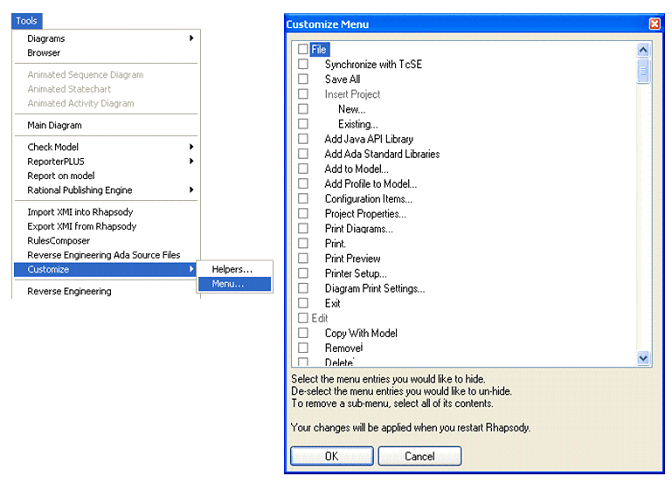
Automated completion assistance for improved performance
The Rational Rhapsody Intellivisor capability helps you find and complete references to existing elements in the browser, dialogs, code editor, and diagrams to help you automate the development process. You can access Intellivisor by using the Ctrl+Space key sequence. It shows the current scope of possible elements. Rational Rhapsody 7.6 improves auto-completion assistance by showing local context when inserting a “.” (reference selection) or “->” (pointer selection) character or when showing namespace completions when inserting “::” characters (scope resolution operator). Additionally, filtering that is based on the current prefix and completion of the generation of events with GEN macros is improved
On-demand model loading
Rhapsody can be used on very large and complex applications. This might mean that it requires more computer resources to represent the design. However, an individual user often might not need to see all of the information contained in the model, because it might be outside of the scope of work that their team is doing. Version 7.6 includes a new capability that loads only portions of the model when a user brings it into the relevant scope of work. This can reduce the size of the model that is loaded to improve performance and computer resources used. Loading occurs implicitly as you work and bring items into context, such as opening feature dialogs or opening diagrams. Optionally, you can also request that elements be loaded.
XMI toolkit improvements
Interchange of model information with other tools through XMI (XML Metadata Interchange) is enhanced to better manage data and improve import support. As part of the ongoing support of the Model Interchange Working Group (MIWG), improvements are added to improve SysML parametric diagram support, importing and exporting of instance specifications, and managing complex activity diagram information, such as flow final, swim lanes, and actions. IBM® Rational Rose® RealTime users who want to migrate to Rational Rhapsody might need to go through a transition step, through Rational Software Architect, to generate XMI information. Improvements in Rational Software Architect import of states, collaborations, and sequence diagrams ease this transition. Additionally, improvements in importing Sparx Systems Enterprise Architect models help you take advantage of more constructs if you are migrating to Rational Rhapsody.
Software Development Improvements
Usability and customization for software development
Rhapsody 7.6 provides new features to help control the results of code generation and work in a more flexible fashion:
· Improved support for C++ «Friend» dependency by allowing the generation of a friend statement in the dependency owner class, which improves roundtrip ordering and allows friend dependency on the template class, plus other improvements
· Simultaneous use of external code editors and navigation in Rhapsody to be able to see more information while editing code
· Support for unions and bounded strings for CORBA to allow modeling of more CORBA constructs
· Improved handling of header guards during reverse or roundtrip engineering when using code-centric settings
Custom formatting of generated code
New properties are added that provide more control over the formatting of the generated code. When C or C++ operations with more than two parameters are generated, the property of the MultiLineArgumentList operation allows you to specify that each parameter of the operation will appear on its own line.
You can also control the indentation of code for C, C++, Java or C# by using the Indentation property to specify the number of spaces used to indent the code. It is now possible to specify that the class or package code for C or C++ and files for C are generated only into a specification (.h) file without a corresponding source file (.c or .cpp). The Generate code generation property for a file (under [lang]_CG::File) adds the Specification and Implementation values that you can select for the class, package, or file (for C), so you can control the files generated. The value of Specification results in the generation of only an .h file, and the Implementation value generates only a .c or .cpp file. A value of True (the default) generates both.
Eclipse code synchronization improvements
The Eclipse plug-in enables co-development by using Rational Rhapsody and the Eclipse platform to leverage the Eclipse platform’s automation and flexibility capabilities and Rational Rhapsody for its visual development environment. There are two variants of the integration:
· Eclipse Platform integration plug-in, which enables a single integrated environment and the workflow integration that provide navigation
· Eclipse Workflow integration, which enables synchronization between development in Rhapsody or Eclipse windows
Version 7.6 improves its integration with both Eclipse integration variants by easing creation of Eclipse projects from Rational Rhapsody by providing properties for default settings that can silently create Eclipse projects. Additionally, it is possible to round-trip code file changes in the active Eclipse project without a matching active configuration in Rational Rhapsody Specifically, for the workflow integration, management of the UDP ports used for communication between Eclipse and Rational Rhapsody is improved to better prevent conflicts on the ports.
Runtime optimization for ports
The generation of C++ code for ports is improved to directly call the operations between behavioral ports rather than going through delegation, to help improve runtime performance and make it easier to debug an application. This feature is for C++ service ports only. It is enabled by the OptimizePortConnectors property for the code-generation component. It is possible to avoid the optimization on specific ports by using the Boolean property, IncludeInConnectorOptimization.
Figure 12. OpB called directly from partA and avoid delegation between higher-level ports
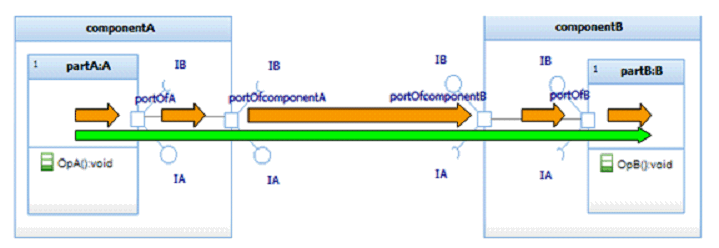
Updated Android, Eclipse, and Visual Studio support
Rational Rhapsody 7.6 updates support for Android and Eclipse by supporting Android 2.3 SDK and Eclipse 3.6.2. Additionally, Version 7.6 supports Microsoft Visual Studio 2010 as a target compiler environment. For more detailed information on supported integrations, see the Resources section at the end of this document for a link to the Rational Rhapsody 7.6 technotes.
Ada development improvements
Reverse engineering of record with discriminant subtypes and arrays is improved by defining new stereotypes in the Ada profile to identify the structure of those patterns and bring the code into the modeling environment.
Improvements for Ada properties include keyword substitution, description template, post processor, and Pragma management
Note:With this release, the Booch component files are no longer distributed with the Rational Rhapsody installation for licensing reasons. If a construct is used that might require Booch components, such as unbounded relations, qualified relations, or multicast ports, a warning is issued and the components need to be installed manually.
Rules Player for Rhapsody Architect for Software
The Rational Rhapsody Developer Rules Player Add On can now be used with Rational Rhapsody Architect for Software (see the Resources section at the end of this document) allowing the integration of Rhapsody models with other inputs and outputs of the engineer’s process. The mapping of the rules would be defined by using the Rational Rhapsody Developer Rules Composer Add On and then deployed as a tool menu option across the team. Users of Rational Rhapsody Architect for Software or Rational Rhapsody Developer could then execute the transformation defined.
Software Design Description documentation templates
The Software Design Description (SDD) describes the design of a Computer Software Configuration Item (CSCI). It describes the CSCI-wide design decisions, the CSCI architectural design, and the detailed design needed to implement the software. Rational Rhapsody 7.6 provides an IBM® Rational® Publishing Engine template for generating a description that is compatible with the SDD specification (DI-IPSC-81435A) to help automate delivery of documentation.
Automotive and constrained target improvements
Enhanced usability for MicroC
Rational Rhapsody 7.6 provides improvements to make it easier to specify initial instances and provide checks in the MicroC framework to avoid design errors. Specifying initial values of class attributes, based on the context where the class is being instantiated, is often required. For example, when a class might be instantiated multiple times or used as a part of different classes, it might be required to specify different initial values. A dialog window is provided to initialize statically inherited attributes, values for fields of record type attributes, array types with multiplicity greater than one, or a combination of all of those.
Rational Rhapsody provides a vey flexible development environment that allows you to be creative in your development and not restrictive in the constructs that you specify. But this could lead to the use of constructs that might not be a best practice. Fortunately, a customizable check model feature is also available that can detect potential design errors early.
Rhapsody provides the ability to specify segmented memory to direct the compiler to allocate data in a specific memory segment. This data can be placed in ROM, or it could be an attribute of file, class, or implicit object. In Version 7.6, new checks are added into the MicroC profile for objects or class parts with a multiplicity value greater than one that also own segmented memory attributes. Additionally, a warning for service ports with operations in their interfaces that might require dynamic memory allocation is provided.
Figure 13 shows how you can specify the static initialization values of multidimensional arrays, fields of record type attributes, and arrays of records with the initial values tab of the features dialog.
Figure 13. Features dialog and generated code of object with initialization

New checks in the MicroC profile detect whether a service port has an operation that requires dynamic memory allocation (see Figure 14).
Figure 14. Warning message for service port on block

Figure 15 shows an example of an error notice for a class with parts with multiplicity set to 2, which specifies segmented memory.
Figure 15. Error message with part blocks nested in the class
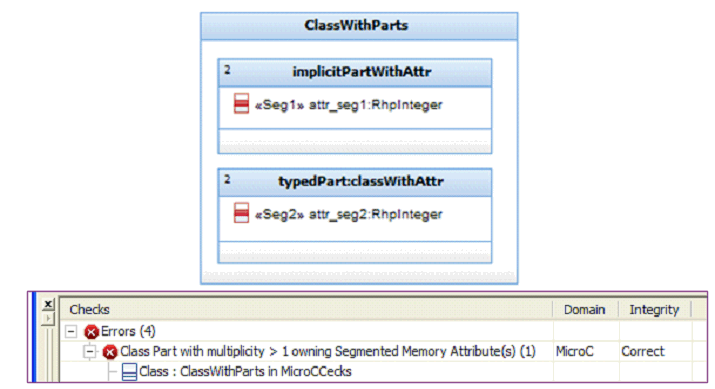
Enhanced usability for AUTOSAR
AUTOSAR code generation enhancements
AUTOSAR, the Automotive Open System Architecture, is growing in importance as more automotive manufacturers and suppliers migrate to it as a common platform for development of vehicle electric and electronic (E/E) systems that consist of many electronic control units (ECUs).
Rational Rhapsody Developer for C improves its code generation of AUTOSAR software components by supporting multiple instances of AUTOSAR SW/C implementations. Additionally, automation of direct activation of triggered operations as entities that can be run is possible.
Support for AUTOSAR XML (ARXML) roundtrip
The interchange of AUTOSAR information is enhanced with the support for roundtrip use of AUTOSAR XML (ARXML). You can now modify the ARXML generated and have the changes synchronized with the Rational Rhapsody model. This enables a flexible development workflow and maintains consistency in information.
Documentation Updates
Web delivery of documentation
The documentation for IBM Rational Rhapsody v7.6 is now available for download from the web so that it can be updated and improved after release of the product and to make the size of the installation file smaller. Users who want a local copy of the documentation can download it and use it locally (see the “Changing the location of help content” link in the Resources section at the end of this document).
New tutorials
Two new tutorials are available in the Rational Rhapsody Information Center for this release:
· “Managing requirements with Rhapsody Gateway and DOORS,” which guides you through the steps needed to manage requirements, traceability, coverage, and impact analysis across a project lifecycle
· “Create a Data Distribution Service for Real-Time Systems application,” where you learn to create a Data Distribution Service for Real-Time Systems (DDS) application by using IBM Rational Rhapsody Developer for C++.
Property definition documentation
The documentation of properties that is available within the product features help window is also now in the Rational Rhapsody Information Center to make it easier to find information about properties (see the Resources section at the end of this document for a link).
Requirements engineering improvements with Rational Rhapsody Gateway
Improving RTF synchronization to Rhapsody
An option is available to import and synchronize requirements that are using rich text formatting (RTF). The descriptions can be added to the Rhapsody model as high-level requirements with the rich text formatting preserved when imported into Rhapsody using the Add High-level Requirement function.
Layout option for Rational DOORS export
The Rational Rhapsody Gateway Add On adds a new package layout option to export Rational Rhapsody information to Rational DOORS so that there is one folder and module for each Rhapsody package. This allows for better organization and navigation of large Rational Rhapsody models.
Excel and CSV to XML
With the Rational Rhapsody Gateway Add On, you can now capture Microsoft Excel or CSV files as XML to make it easier to identify patterns and improve the extraction results. A tester is also provided to help validate the XML that is created.
Summary
The Version 7.6 releases of software in the Rational Rhapsody family extend design into the broader lifecycle’ assist in delivering safer, high-quality designs’ and improve the user experience with a new look and usability improvements. The introduction of Collaborative Design Management provided with Rational Rhapsody Design Manager 3.0 can enable the extended team to access the design by using a web client, to search across designs, and to collaborate with comments and markups.
Rational Rhapsody 7.6 enables systems engineers to better analyze and validate requirements using activity diagrams simulation, co-simulation with Simulink, and modeling improvements. Development of safety-critical applications is improved with a new execution framework that supports ARINC 653, enhanced testing capabilities, and better support for MISRA code generation.
You can find more detailed information about the new features in the Rational Rhapsody Information Center (see the Resources section).
Resources
Learn
To learn more about this tool for collaborative, model-driven development for embedded systems, start with the Introduction to Rational Rhapsody and the Rational Rhapsody page on IBM developerWorks. Also see the Rational Rhapsody 7.6 information center and the technotes (release notes).
See Changing the location of help content to get a local copy of the documentation.
Explore the various versions, too:
· IBM® Rational® Rhapsody® Architect for Software, a visual development environment for embedded systems and software
· IBM® Rational® Rhapsody® Architect for Systems Engineers
· IBM® Rational® Rhapsody® Designer for Systems Engineers
· IBM® Rational® Rhapsody® Developer for collaborative, model-driven development of embedded systems. This edition is required for Eclipse users, and editions are available to create specialized projects in C, C++, Java, and Ada languages.
Check the IBM® Rational® Rhapsody® Design Manager to collaborate, share, review and manage designs and models with the entire engineering team. Also see the Design Management page on Jazz.net
Other Rational products mentioned in this article:
· Rational DOORS requirements definition and management application
· Rational Harmony for Systems Engineers
· Rational Publishing Engine automated document generation tool
· Rational Software Architect design software
Visit the Rational software area on developerWorks for technical resources and best practices for Rational Software Delivery Platform products.
· Attend a free developerWorks Live! briefing to get up-to-speed quickly on IBM products and tools, as well as IT industry trends.
· Follow developerWorks on Twitter.
· Watch developerWorks on-demand demos, ranging from product installation and setup demos for beginners to advanced functionality for experienced developers.
Check the Rational training and certification catalog, which includes many types of courses on a wide range of topics. You can take some of them anywhere, any time, and many of the “Getting Started” ones are free.
Get products and technologies
Download Rational Rhapsody Developer and try it free for 30 days.
Learn more about the Design Management project on Jazz.net.
Evaluate IBM software in the way that suits you best: Download it for a trial, try it online, use it in a cloud environment, or spend a few hours in the SOA Sandbox learning how to implement service-oriented architecture efficiently.
Discuss
Join the discussion in the Rational Rhapsody forum.
Share your knowledge and help others who use Rational software by writing a developerWorks article. You’ll get worldwide exposure, RSS syndication, a byline and a bio, and the benefit of professional editing and production on the developerWorks Rational website. Find out what makes a good developerWorks article and how to proceed. Start by finding out what makes a good developerWorks Rational article.
Follow Rational software on Facebook, Twitter (@ibmrational), and YouTube, and add your comments and requests.
Connect with others who share your interests by joining the developerWorks community and responding to the developer-driven blogs.
Product Synonym
Rational Rhapsody
Was this topic helpful?
Document Information
Modified date:
27 May 2022
UID
swg27021396